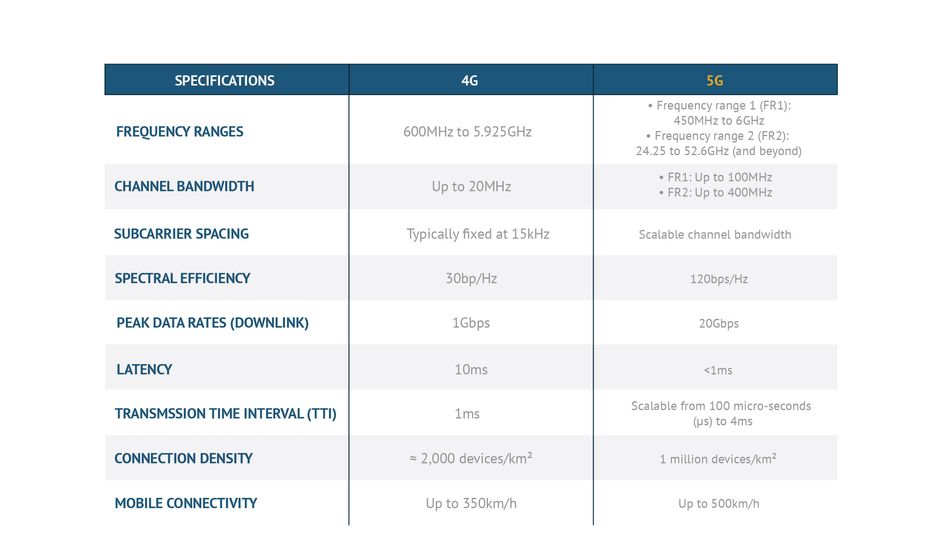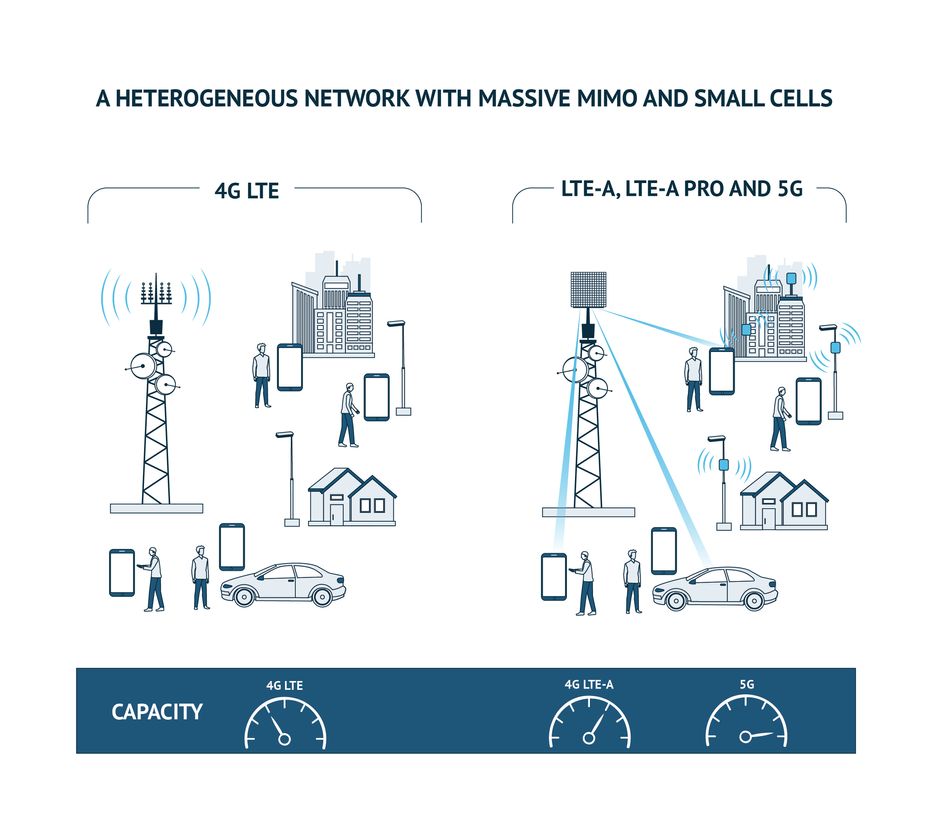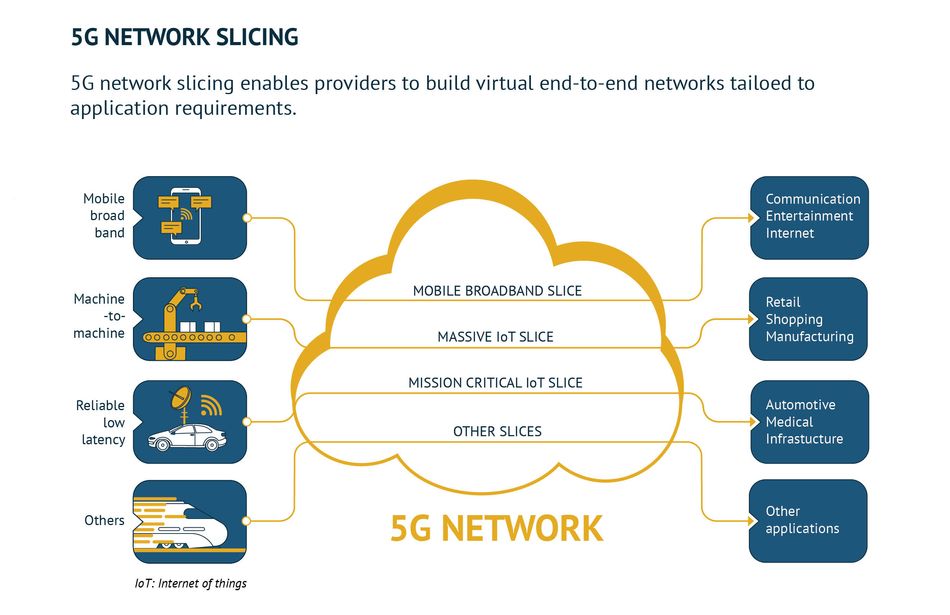An introduction to 5G
Article 2 of our 5G Series: An introduction to 5G performance, technology, and specifications and how it makes new applications possible.

This is the second in an eight-part series exploring 5G. The series will explain key terms and technologies and provide an overview of current and future applications for 5G connectivity.
The articles were originally published in an e-magazine, and have been substantially edited by Wevolver to update them and make them available on the Wevolver platform. This series is sponsored by Mouser, an online distributor of electronic components. Through their sponsorship, Mouser Electronics supports a more connected future fuelled by knowledge and innovation.
Introduction
The 5G mobile communications standard is designed to fulfill several performance and use case requirements currently not possible in 4G networks, including:
- Enhanced broadband that brings fiber-optic speeds and bandwidth to over-the-air (OTA) connections
- Low latencies and extreme reliability for realtime OTA process control
- Much higher device densities that will enable the massive Internet of Things (IoT) connectivity that is anticipated in smart cities
- More energy efficiency to meet the increasing demand for low-power connectivity
- High-speed adaptability for high-speed mobile applications
- On-demand network scalability to meet the requirements of many industrial use cases
Specifications outlined in 3rd Generation Partnership Project (3GPP™) Release 15 provide details for 5G New Radio (NR), which addresses the 5G air interface, and 5G Core, which deals with network functions. Both 5G NR and 5G Core are required to meet 5G performance expectations. This article looks at how 5G differs from 4G with respect to its performance, radio access technology, and network core functions. It further reviews how 5G specifications make new applications possible and how the 5G standard impacts component designs.
How Does 5G Differ from 4G?

Meeting 5G’s performance expectations requires additional spectrum as well as different waveforms and a flexible framework that allows service multiplexing and more dynamic multiple access capabilities. 5G meets these requirements through a new approach to scalable waveforms that works across a range of frequencies, creating an entirely new approach to session and network management.
5G NR Increases Flexibility and Reduces Overhead
5G NR applies a common waveform framework that scales across a range of bandwidths. Several techniques contribute to 5G’s spectrum efficiency, flexibility, and reduced power consumption. Key differences between 5G NR and 4G Long-Term Evolution (LTE) include:
- Scalable orthogonal frequency-division multiplexing (ODFM) numerology. ODFM is a widely used waveform for encoding digital communications. Its waveform numerology defines the structure and timing of information resources that the waveform carries, such as the number of subcarriers and the subcarrier spacing. Both 4G LTE and 5G NR use ODFM, but there are big differences. In 4G LTE, the numerology is always fixed; in 5G NR, the numerology is scalable for optimization in different bandwidths. This means that the subcarrier size and spacing are scalable to fit bandwidths that different frequencies provide. It also enables scalable TTI, which makes it possible to adjust latencies from very low for short-duration transmissions to longer latencies that make transmitting large data packets more efficient. Scalable ODFM numerology is the heart of 5G’s scalability and flexibility.
- Self-contained subframes. Introduced in the 5G NR specification, these structures enable the inclusion of data along with their transmission acknowledgments in the same subframe, further reducing latencies. They also enable the multiplexing of different kinds of subframes, and they support blank subframes to accommodate undefined future services. Self-contained subframes can also contain beamforming data specific to a transmission, which supports multiple-input, multiple-output (MIMO) antenna transmissions and reduces interference.
- Device-centric mobility. In LTE networks, receiving devices measure reference signals that base stations transmit to decide where to connect. Base stations transmit reference signals continuously, regardless of the presence of a receiving device—which requires processing overhead on the receiving device and excess power consumption by the transmitting equipment. In 5G transmissions, receiving devices transmit a reference signal when they need a network connection, and this reference signal triggers communication and handoff activities using appropriate transmitting equipment. This arrangement reduces power consumption and the number of reference signal broadcasts.
- New cell architectures and antenna designs. To support larger numbers of connected devices, uninterrupted communications, and shorter operational ranges available from high-frequency bands, 5G will require denser cell architectures than are found in 4G LTE networks. Typical deployments could include a mix of macro-cells operating in low frequencies for wide outdoor coverage, small cells operating indoors and outdoors in mid-frequency ranges, and micro-cells (room sized) operating primarily indoors at millimeter wavelength frequencies. Beamforming techniques using massive MIMO (mMIMO) antenna arrays will provide uninterrupted coverage and much higher transmission efficiencies than 4G LTE produces with previous MIMO variations. 5G antenna designs will also produce more signal processing at the antennas to manage mobile device handoffs between cells.

5G Core Virtualizes 4G Evolved Packet Core Network Architecture
To meet 5G performance specifications, especially as they relate to use case flexibility, scalability, and reliability, the 5G Core network has been redesigned from the ground up in a way that completely supplants the 4G Evolved Packet Core (EPC). Whereas 4G EPC relied on physical network elements, 5G Core is a cloud-native virtualized architecture that uses multi-access edge computing to deliver network functions as services to a network’s edge. Key features and capabilities of the 5G Core architecture include:
- Separate control plane and user plane functions. This separation and reallocation of functions previously performed by EPC service and packet gateways enable a redistribution of packet processing functions to a network’s edge. The result is better traffic management and scalability.
- Redesign of session management functions. Mobility management and session management are now performed by different network elements, and new identity and authentication functions have been added. All this improves session management to deliver uninterrupted service in various operational scenarios—for example, as user equipment is moving through a small cell network or at high speeds. These session management enhancements create a reliable service flow in complex environments that contain dense IoT arrays and user equipment with diverse data formats.
- Network slicing. This technology enables 5G to offer a “slice” of the network as a dedicated service for a particular use case, customer, or industry. User equipment can simultaneously access multiple network slices. A network slice maintains all necessary functionality and quality across domains and technologies to efficiently allocate available resources for each use case.

New Applications and Business Cases Possible with 5G
The 5G standard enables a range of simultaneous communications that are highly reliable and optimized for use case performance and power consumption. This standard opens the door to a host of new smart services and partnerships that could not previously be accommodated on monolithic 4G networks.
Recommended reading: 5G Infrastructure Enables New and Radical Applications
Use Case Possibilities: Life in a 5G World
To illustrate some of the possibilities in a 5G world, consider a simple example of an architect’s commute to work one morning in her autonomous vehicle (AV). It happens that she has scheduled a conference call to take place during her commute because this was the only time her clients in Spain and her supplier in Singapore could meet.
Seamless Communications
The architect can carry on with her meeting as her AV navigates itself to her office. It does this by using a 5G vehicle-to-everything (V2X) communications platform for low-latency communications. The AV’s communications platform is cloud-based and interacts with other vehicles and traffic control infrastructures, using data from sensor inputs for real-time situational awareness and navigational updates.
While the AV drives, the architect reviews her project plans, then puts on her headset to enter a virtual three-dimensional (3D) conference call that uses a 5G broadband full-duplex connection. During the meeting, the AV enters a tunnel on the route to work. There is no interruption in the meeting or the vehicle’s control systems because the tunnel is lined with small cell mMIMO antennas, which maintain a continuous contact for all communications while the vehicle is moving underground. Soon after the AV enters the tunnel, its calculated arrival time triggers a signal that turns on a coffee machine in the architect’s office.
Tasks Accomplished
Despite all the activity, the meeting goes as planned. The AV arrives at its destination, locates an available parking space, parks itself, engages the electric-charging equipment, and verifies the payment account information. Thereafter, the architect walks into her office, pours a cup of hot coffee, and updates her project plans based on information her supplier in Singapore provides.
This example shows how 5G technology’s ubiquitous real-time command, control, and communications capabilities will reshape the way process control and workflows operate. It will also open the door to entirely new models. Fully entering this world, however, will still require a lot of engineering work.
Engineering Challenges for 5G Components
5G performance requirements combined with 5G network and device architectures are placing new demands on component design. Many design constraints are interdependent. They include:
- Processing power and throughput. Many aspects of 5G technology require more processing power, including scalable waveforms, higher data throughput, smaller cells that require complex session and handoff management, beamforming, network slicing, and higher connected device densities. More processing power requires more robust software, which in turn consumes power and generates heat.
- Power consumption. Although 5G devices are expected to use power more efficiently, they will also do more work. Early base stations with MIMO antennas and prototype 5G phones will consume two to three times more power than their 4G counterparts.
- Heat. More power consumption means more heat generation, which requires more heat dissipation to avoid damaging components.
- Component complexity. 5G components are more complex, with more filters and amplifiers to operate at more frequencies and with more complex waveforms. This complexity introduces risks of creating larger components when space is already at a premium, especially in user equipment.
- Component density and compact designs. Packing more complex components into more compact designs increases component density, which makes heat dissipation more difficult.
These challenges can have a cascading effect of design constraints. For example, in a device like a mobile phone, if components take up more room, there is less room for a battery, so the battery must be smaller. But, if the device needs more power, smaller batteries mean less available power, which in turn means a shorter service time between charges. Many of these heat, power consumption, and component size challenges are being addressed through new techniques and materials—for example, through:
- Transceivers that employ new phase-shifting techniques—which allow more accurate beam steering, tighter beam resolution, near-zero gain variations across a large MIMO antenna array, higher data rates, and package size reductions through components that share circuit elements—eliminating the need for switches,
- More efficient high-frequency power amplifiers that use gallium nitride (GaN) transistors and a variety of techniques for reducing nonlinearization when operating at less than full power, and
- New techniques for developing reconfigurable and tunable wideband filters that are compact and cost-effective.
Conclusion
5G communications are here, and initial deployments have already begun, but clearly a lot of engineering work remains to be done before 5G technology can deliver all the possibilities that its specification implies. Initial deployments focusing on FR1 (<6GHz) will be the proving ground for new 5G systems and components going forward.
This article was originally written by Mustafa Ergen for Mouser and substantially edited by the Wevolver team. It's the first article of a series exploring 5G. Future articles will explore how 5G differs from existing technology and how the potential of hyper-connectivity will be applied in entertainment, smart cities, and industry and how to get there.
Article One gives an overview of 5G.
Article Three discusses how systems engineers can evaluate the viability of 5G in the existing connectivity ecosystem.
Article Four examines the relevant standards associated with 5G.
Article Five showcases the radical applications 5G will enable.
Article Six looks at the ecosystems of 5G infrastructure.
Article Seven dives into 5G Antenna Designs.
About the sponsor: Mouser Electronics
Mouser Electronics is a worldwide leading authorized distributor of semiconductors and electronic components for over 800 industry-leading manufacturers. They specialize in the rapid introduction of new products and technologies for design engineers and buyers. Their extensive product offering includes semiconductors, interconnects, passives, and electromechanical components.
